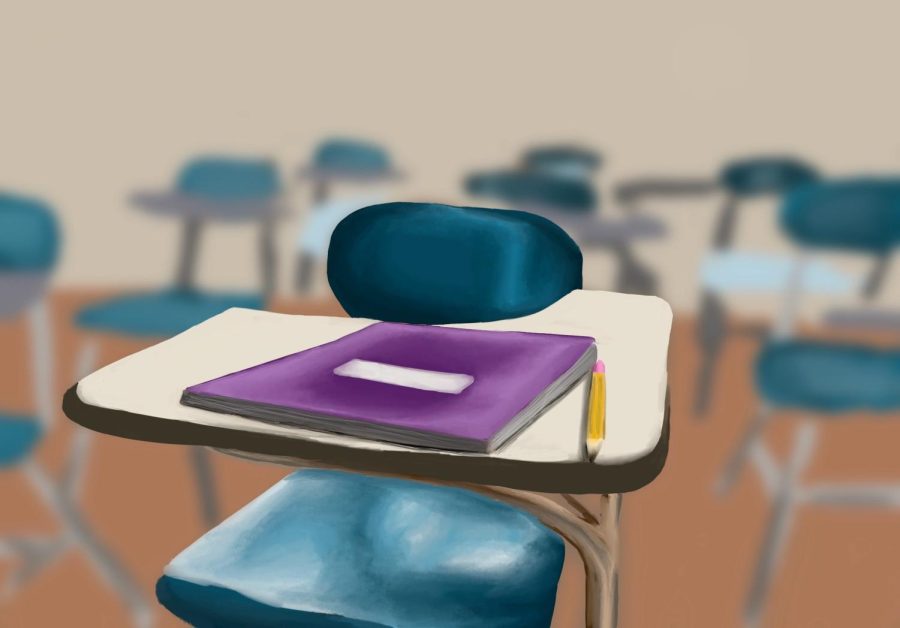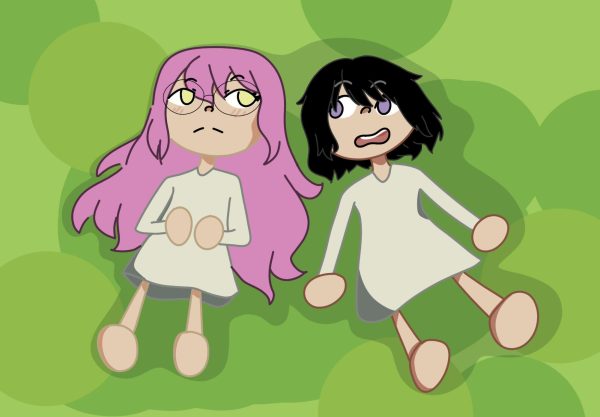Table Groups Prove Beneficial For Students
Table groups allow for better collaboration among students.
Each year, teachers have the difficult decision of how to configure their classroom seating charts. With traditional rows, pairs, table groups, large semi-circle, double horseshoe table arrangements, or a combination of these, the options are endless. Furthermore, each layout comes with benefits and drawbacks. The big question is, what is best for students?
At Campolindo, I have observed that the majority of teachers choose to keep the traditional rows. Many science teachers have their tables arranged so 2 people sit next to each other with larger lab tables for 4-person group work. Very rarely have I noticed classes with table groups or the semi-circle arrangement.
The traditional rows most Campo classrooms have is shown to be best for reducing talking, since the set-up faces all students towards the front in individual desks. This method was specifically designed for lectures and increasing focus on the teacher. However, 1 disadvantage to this method is the reduced cooperative learning. Students aren’t able to get to know each other as well as other formations allow for. Furthermore, students placed towards the back of the classroom are more likely to get distracted and disengaged since they are very far away from the teacher. I have observed that rows tend to make students less likely to volunteer to answer questions and make class participation more challenging.
English teacher Matt Ridenour said his classroom is arranged in rows because “it became the easiest thing to negotiate with the new cleaning cleansing station that was implemented last year. I did not have it in rows until this year. Before [my room was organized in] groups of 4.” Ridenour also added that “it’s more space effective to have [the classroom in rows]…[but], small group discussion stuff, is a lot easier the way that I used to have my desks laid out in groups of 4.”
Another option commonly implemented in Campo science classrooms is pairs. This method is shown to create an environment where partnership and collaboration are likely. Many Campo science classes also have lab tables where students will work in larger groups, generally of 3 to 4 students. This combination allows for more social interaction between students while still fostering a productive classroom environment. However, a downside to this is that off-task behavior is possible.
Science teacher Patrick Wildermuth said, “[The science department] as a whole decided that we like the [pairs] tables more because it gives us more space to spread out.” He mentioned that the pair desks are larger than the normal desks, so it allows for more space to work and place your materials. “There’s space for your computer and your paper, and whatever we’re [working on],” said Wildermuth. 1 disadvantage Wildermuth added was if you are placed with someone you don’t like working with, but he said most teachers would be flexible with this.
The U-Shape or large semi-circle, proven best for classroom conversations between students and ensuring that all students can see the board, is a layout rarely seen at Campolindo. This arrangement can also be organized into a double horseshoe shape, which offers a slightly more restricted form of discussion. Some negatives to this setup are that it requires a lot of space and is harder for students to get around the classroom.
Lastly, a version seldom noticed at Campolindo: table groups. Table groups, an arrangement commonly seen throughout elementary school and into middle school has seemingly vanished in high school. The classroom setting is great for group work and collaboration, allowing students to get to know each other and bounce ideas off each other. Many reasons why teachers fear this method is because it makes keeping talking to a minimum more challenging. While this is a valid concern, by high school, students have learned when talking is appropriate and how to keep it to a minimum. If teachers establish the ground rules about how discussion should only happen when instructed by the teacher, this should not be an issue. Table groups will allow students to become closer friends while still improving their academic skills as they will be able to work together.
English teacher Darrion Carlyle said, “I have my classroom arranged in table groups because I believe that collaboration is a really helpful way to promote learning.”
Freshman Madeline Martindale said she prefers table group arrangements: “I can collaborate with people and otherwise we have to turn around. Normally people don’t want to talk to one another when you’re sitting in rows because they think that it’s just too awkward to turn around or look next to the person next to you.”
Senior Adriana Colon said most of her classes are arranged in rows or rows facing the center of the class. “It’s definitely a little bit more secluded [being in rows… [and] it’s somewhat harder to talk to people.”
She added that her personal favorite seating arrangement is pairs because “you build a connection with that person over time, especially if you’re sitting with them for like semesters or quarters. I think it’s a great way to get to meet people and you also foster a connection because we both have to speak to each other.”
Carlyle believes table groups are beneficial for students because they promote more group discussion: “It allows for students to feel like it’s more of a social environment compared to an environment where everything is rigid.”
He added that table groups are only a disadvantage to students if they allow it to be a disadvantage. “A lot of table groups have an issue of not knowing when to not talk. Some tables have an issue of not helping each other [stay on-task],” said Carlyle.
It seems that the consensus of students and teachers is that collaboration should be a part of the classroom. The traditional row seating arrangement is preventing students from improving by learning from their peers since rows allow for very little teamwork. Table groups allow students to collaborate with several different students versus pairs, which is limited to 1 partner. While a semi-circle method could be beneficial to students, most Campo classrooms can’t accommodate this expansive organization.
Table groups are overall the best option for students. This arrangement creates a collaborative environment where students can help each other while still learning. It also prevents a very rigid and stressful environment that rows can often enforce in the classroom, due to the lack of communication between peers. “When you’re faced at each other with [the table group desks], it’s a little bit hard not to make a comment or speak with the person next to you,” said Colon.
Campo teachers should consider rearranging their classrooms to table groups to create an environment that is both positive for students and manageable for teachers.
Your donation will support the student journalists of Campolindo High School's The Claw. Your contribution will allow us to produce more issues and cover our annual website hosting costs.

When she was 4 years old, Claire Birdsey was enrolled in her first dance class and has been hooked ever since. Dancing at CAPA in Moraga since 2017, she...

Alex Gonzales is a senior and a 1st year journalism student on the Art Staff. Gonzales grew up in Montclair before moving to Lafayette. “I joined journalism...


